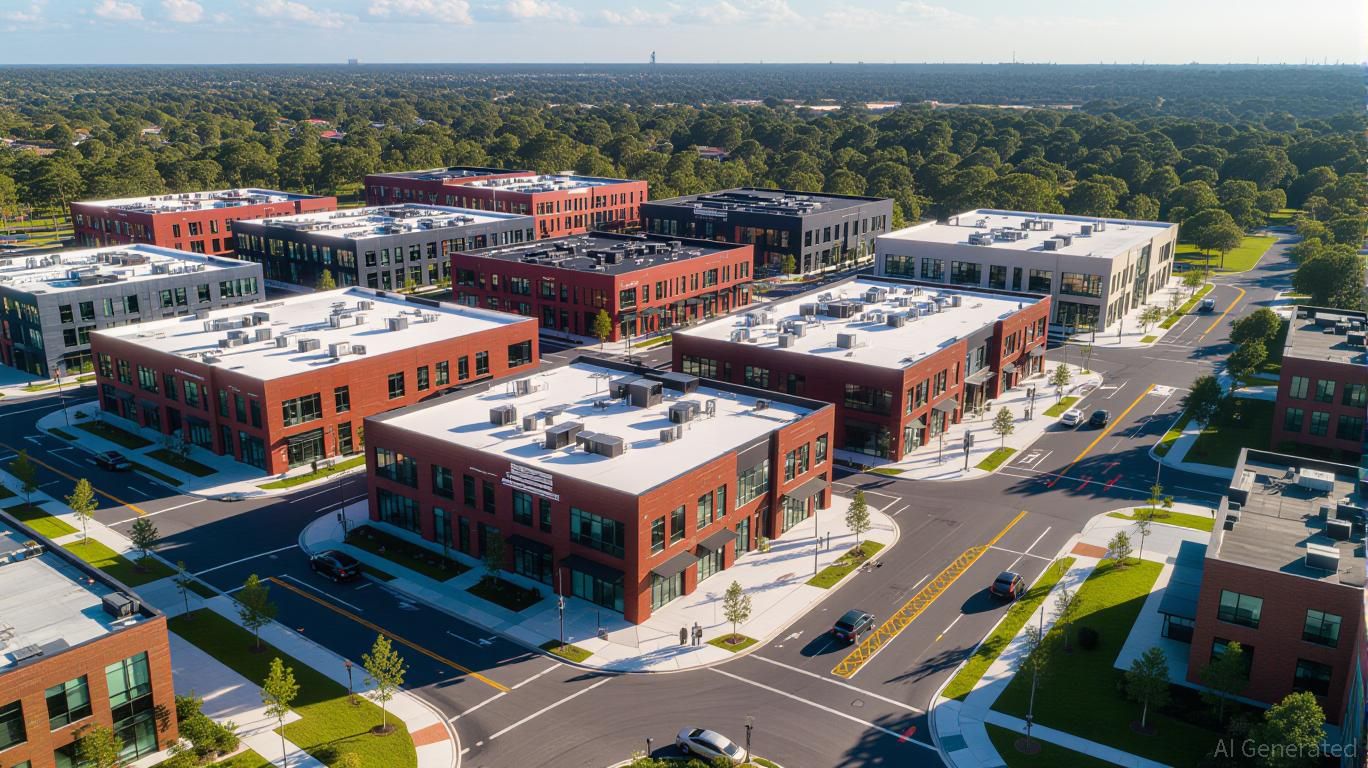Unlocking Potential in Industrial Properties: The Revitalization of Xerox Webster Campus
- Xerox Webster Campus in NY transforms 300-acre brownfield into industrial hub via $9.8M infrastructure upgrades and public-private partnerships. - State-funded projects including road improvements and sewer expansions unlock 1M sq ft of modern industrial space for manufacturing and tech sectors. - Governor Hochul's "sustainable ecosystem" strategy aligns with infrastructure-driven development, attracting semiconductor and renewable energy industries. - Shovel-ready model reduces construction risks, offer
A Framework for Infrastructure-Driven Expansion
Central to the Xerox Webster Campus redevelopment is a $9.8 million FAST NY grant, which has

Scaling Up Through Public-Private Partnerships
The Xerox Webster Campus illustrates how public-private partnerships (PPPs) can help manage risks in large-scale industrial developments. By blending government and private funding, the project overcomes many of the financial and regulatory challenges typical of brownfield projects. For example, the $500,000 federal grant for the Community Access Project shows how
This approach is especially relevant in the current industrial property market. According to a 2025 Clarion Partners report,
Investment Opportunities in Ready-to-Build Markets
The Xerox Webster Campus is part of a broader trend. From 2023 to 2025, industrial real estate investment has increasingly focused on returns tied to infrastructure. While short-term obstacles like softer rents and economic uncertainty remain,
Developers are shifting toward smaller, multi-tenant buildings that provide more stable cash flow and reduce the risks of single-tenant properties
Meanwhile, private equity groups are expanding into infrastructure and private credit to achieve distinct returns
Wider Lessons for Industrial Real Estate
The Xerox Webster Campus redevelopment also demonstrates the value of municipal adjustments in unlocking potential. By updating land use classifications and simplifying permitting, local authorities can speed up industrial growth in areas that have been underutilized. This is especially significant in regions like the Sunbelt and Midwest, where
For REITs and private equity, the message is clear: infrastructure-led development is now a mainstream approach. Clarion Partners points out that
Conclusion
The Xerox Webster Campus redevelopment is more than just a local achievement—it reflects the broader transformation of the industrial real estate sector. By integrating infrastructure upgrades, public-private partnerships, and innovative design, the project shows how industrial properties can be repositioned to address the needs of a post-pandemic economy. For developers, REITs, and private equity, the main lesson is clear: in a time of supply chain shifts and the rise of e-commerce logistics, the best opportunities are found where infrastructure investment and strategic planning intersect.
Disclaimer: The content of this article solely reflects the author's opinion and does not represent the platform in any capacity. This article is not intended to serve as a reference for making investment decisions.
You may also like
The Iceberg Phenomenon: Unseen Dangers of AI’s Labor Force Surface Across the Country
- MIT's Iceberg Index reveals AI could replace 11.7% of U.S. jobs ($1.2T in wages), impacting sectors like finance and healthcare beyond tech hubs. - The tool maps 151M workers across 923 occupations, highlighting hidden risks in routine roles (e.g., HR, logistics) versus visible tech layoffs. - States like Tennessee and Utah use the index for reskilling strategies, while C3.ai partners with Microsoft to expand enterprise AI solutions. - Despite C3.ai's market expansion, its stock faces volatility, reflect
Where Saving Animals and Supporting People Come Together: The Gentle Barn's Comprehensive Approach
- The Gentle Barn, a California-Tennessee sanctuary, merges animal rescue with human emotional healing through acupuncture, mobility aids, and therapeutic interactions. - Its volunteer programs and $75 season passes support financial sustainability while fostering compassion between humans and rescued animals like turkeys and hoofless goats. - The nonprofit's holistic model attracts attention as a case study in combining veterinary care with mental health initiatives, despite scalability challenges in nonp

XRP News Today: With Tether and USDC under examination, RLUSD from the UAE stands out as a regulatory-compliant stablecoin option.
- Ripple's RLUSD stablecoin received ADGM approval as a regulated fiat-referenced token in Abu Dhabi, enabling institutional use in payments and treasury management. - Pegged 1:1 to the USD with NYDFS oversight, RLUSD ($1.2B market cap) offers compliance-driven alternatives to USDT/USDC amid global regulatory scrutiny. - UAE's ADGM-DIFC regulatory framework positions the region as a crypto innovation hub, with Ripple expanding partnerships through Zand Bank and Mamo fintech . - The approval aligns with UAE

ZK Atlas Enhancement: Driving Institutional Embrace Amid the Blockchain Scalability Competition
- ZKsync's Atlas Upgrade solves throughput bottlenecks with Airbender RISC-V zkVM, enabling 15,000+ TPS at $0.0001 per transaction. - Modular ZKsync OS reduces gas fees by 70% since 2023, enabling real-time financial applications while maintaining regulatory compliance. - Deutsche Bank and UBS test ZKsync for asset tokenization, highlighting its institutional appeal through privacy-preserving ZK features and sub-second finality. - Upcoming Fusaka upgrade aims to push TPS to 30,000 by December 2025, but reg
